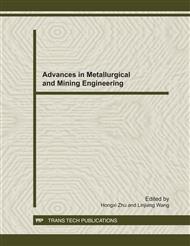[1]
Abdelmounaim, B. and V.J. Pierre, The impact of thermal pre-treatment on oil shale attrition and fragmentation in fluidized bed combustion. Experimental Thermal and Fluid Science, 2004. 28(7): pp.677-682.
DOI: 10.1016/j.expthermflusci.2003.12.004
Google Scholar
[2]
Chenevert, M., Shale alteration by water adsorption. Journal of Petroleum Technology, 1970. 22(9): pp.1141-1148.
DOI: 10.2118/2401-pa
Google Scholar
[3]
Yew, C., et al., Wellbore stress distribution produced by moisture adsorption. SPE Drilling Engineering, 1990. 5(4): pp.311-316.
DOI: 10.2118/19536-pa
Google Scholar
[4]
Chenevert, M. and C. Gatlin, Mechanical anisotropies of laminated sedimentary rocks. Old SPE Journal, 1965. 5(1): pp.67-77.
DOI: 10.2118/890-pa
Google Scholar
[5]
Mody, F.K. and A. Hale, Borehole-stability model to couple the mechanics and chemistry of drilling-fluid/shale interactions. Journal of Petroleum Technology, 1993. 45(11): pp.1093-1101.
DOI: 10.2118/25728-pa
Google Scholar
[6]
Van Oort, E., On the physical and chemical stability of shales. Journal of Petroleum Science and Engineering, 2003. 38(3-4): pp.213-235.
Google Scholar
[7]
Ekbote, S. and Y. Abousleiman, Porochemothermoelastic solution for an inclined borehole in a transversely isotropic formation. Journal of engineering mechanics, 2005. 131: p.522.
DOI: 10.1061/(asce)0733-9399(2005)131:5(522)
Google Scholar
[8]
Díaz-Pérez, A., I. Cortés-Monroy, and J. Roegiers, The role of water/clay interaction in the shale characterization. Journal of Petroleum Science and Engineering, 2007. 58(1-2): pp.83-98.
DOI: 10.1016/j.petrol.2006.11.011
Google Scholar
[9]
Ghassemi, A. and A. Diek, Porothermoelasticity for swelling shales. Journal of Petroleum Science and Engineering, 2002. 34(1-4): pp.123-135.
DOI: 10.1016/s0920-4105(02)00159-6
Google Scholar
[10]
Ghassemi, A., Q. Tao, and A. Diek, Influence of coupled chemo-poro-thermoelastic processes on pore pressure and stress distributions around a wellbore in swelling shale. Journal of Petroleum Science and Engineering, 2009. 67(1-2): pp.57-64.
DOI: 10.1016/j.petrol.2009.02.015
Google Scholar
[11]
Al-Bazali, T., et al., Factors controlling the compressive strength and acoustic properties of shales when interacting with water-based fluids. International Journal of Rock Mechanics and Mining Sciences, 2008. 45(5): pp.729-738.
DOI: 10.1016/j.ijrmms.2007.08.012
Google Scholar
[12]
Zhou, X. and A. Ghassemi, Finite element analysis of coupled chemo-poro-thermo-mechanical effects around a wellbore in swelling shale. International Journal of Rock Mechanics and Mining Sciences, 2009. 46(4): pp.769-778.
DOI: 10.1016/j.ijrmms.2008.11.009
Google Scholar
[13]
Zhang, L., P. Cao, and K. Radha, Evaluation of rock strength criteria for wellbore stability analysis. International Journal of Rock Mechanics and Mining Sciences, 2010.
DOI: 10.1016/j.ijrmms.2010.09.001
Google Scholar
[14]
Zhang, J., J. Lang, and W. Standifird, Stress, porosity, and failure-dependent compressional and shear velocity ratio and its application to wellbore stability. Journal of Petroleum Science and Engineering, 2009. 69(3-4): pp.193-202
DOI: 10.1016/j.petrol.2009.08.012
Google Scholar


